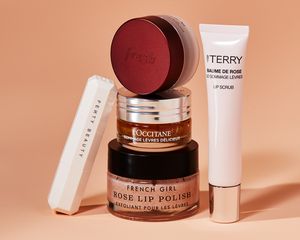:max_bytes(150000):strip_icc()/bearddandruff-1139b087fd6d48798b92b6cc3f11409f.jpg)
Stocksy
Ever since that article was published a few years back that said mens’ beards are cessbushes of microbes and fecal matter, the topic of beard hygiene has earned a permanent spot in the men’s grooming spotlight. Luckily, an entire industry of beard shampoo, beard conditioner, beard oil, and beard balm was born to keep the bearded looking their best. However, while it’s almost commonplace to hear guys casually discuss their favorite beard oil brands, one thing you rarely hear thrown about with glee over a pint of IPA is beard dandruff.
Yes, beard dandruff is a thing, and, lucky for you, so is beard dandruff treatment. But before you self-diagnose and start buying a handful of products, let’s get to the bottom of what causes beard dandruff so you can better understand what’s causing your beard to snow on your chest. We talked to a handful of experts, including board-certified dermatologist Daniel Belkin, MD of the New York Dermatology Group, Dendy Engelman, MD, a board-certified dermatologist at the Shafer Clinic, and top New York City barber and men’s grooming expert Jason Biggs of Babe of Brooklyn to discuss both the cause and beard dandruff treatment options.
Meet the Expert
- Daniel Belkin, MD, is a board-certified dermatologist of the New York Dermatology Group.
- Dendy Engelman, MD, is a board-certified dermatologist at the Shafer Clinic.
- Jason Biggs is a top New York City barber and men’s grooming expert of Babe of Brooklyn.
What is Beard Dandruff?
Beard dandruff is essentially a condition called seborrheic dermatitis, which typically affects the face and scalp, Engelman says. Symptoms include red skin and flaking on the scalp and hair, which can be accompanied by itching. The telltale symptoms of beard dandruff include white flakes in the beard with red skin at the base.
What Causes Beard Dandruff?
“Dandruff is mainly caused by a fungus called Malassezia globosa,” Engelman explains, “which thrives in oil-rich environments—making the scalp a perfect place for it to form. The fungus breaks down oils in your sebaceous glands, leaving behind oleic acid that irritates the skin and results in dandruff. Rapid cell turnover (an overproduction of skin cells) can also contribute to dandruff. If skin cells regenerate too quickly, buildups can form, which create an ideal environment for dandruff-causing fungus to thrive.”
What isn't Beard Dandruff?
Just because you find yourself with a few flakes in your beard doesn’t necessarily mean you’re dealing with beard dandruff. Dry skin can also cause the skin to shed, which may show up in your beard as white flakes. Belkin explains how to tell the difference: “With dandruff, the skin will look normal to pink to red, flakes are larger and greasier, and flaking is seemingly never-ending. When flaking is from dry skin, the skin can look whitish or cracked, and flakes are dry and small.”
Naturally, if you think you have beard dandruff, it’s best to see a dermatologist for a correct diagnosis and course of beard dandruff treatment.
Who Gets Beard Dandruff?
If you normally experience scalp dandruff, you may also be more prone to beard dandruff, Engelman says. That’s because “If your skin cells regenerate too quickly on your scalp, it is common the cells will also do so on your beard.” Belkin says that men are more commonly affected than women because sebaceous glands are responsive to androgens, or male hormones. He also says although there is no known predisposition toward any particular skin type, the redness may be less apparent in those with darker skins; however, the flaking will be similar.
Biggs says that beard length also plays a role in both formation and beard dandruff treatment. “The longer your beard is, the more likely you are to develop beard dandruff.” Engelman agrees, “The longer the beard, the harder it is to reach the skin when washing. This can create a buildup of oils and dead skin, which promotes fungal growth and can lead to dandruff.”
“So trust that long hipster beard needs double the care,” Biggs says, adding that a shorter, more manicured beard that’s closer to the face may be easier to treat.
Beard Dandruff Treatment
“Treating beard dandruff can be complicated and does not have a one size fits all method,” Biggs explains, and our experts all agree that a three-pronged approach to beard dandruff treatment is the most effective: exfoliate, wash, and hydrate.
Exfoliate
“Exfoliating the skin prevents pores from getting clogged and excess oils from being produced,” Engelman explains. She recommends using a beard brush, the soft bristles of which are less likely to irritate skin than a physical scrub. “Gently move the brush across the skin, throughout the beard, to buff away dead skin cells and excess oil.” However, don’t overdo it, as excess brushing could further irritate your already vulnerable skin, causing oil production to overcompensate.
Wash
Belkin recommends an antifungal shampoo such as Head & Shoulders, which contains zinc pyrithione, or Nizoral, which contains ketoconazole, to help reduce the overgrowth of the problem-causing fungus. As a more natural approach, Engelman also recommends Paul Mitchell Tea Tree Scalp Care Shampoo, which contains tea tree oil, known for its anti-microbial and anti-fungal properties.
Hydrate
Since washing and exfoliating can strip away the skin’s natural oils, it’s important to replenish with moisture to prevent skin from drying out, which could cause increased oil production. When it comes to beard dandruff treatment, your typical facial moisturizer may not cut it. Instead, Engelman recommends Melach 33 Rimmon Elixir Face Oil, which contains a blend of antioxidant-rich oils to protect the skin, omega fatty acids to help skin recover, and jojoba oil to balance oil production and calm breakouts. Apply from the root of your beard—closest to the skin—and bring the oil to the ends of your beard while massaging it into the hair to ensure maximum penetration to the skin.
Engelman says that the key to beating beard dandruff at its own game is to be consistent with your treatment. “Keeping your beard clean and hydrated is crucial for preventing beard dandruff. Make sure to establish a beard care routine and stick with it every day.”
When to See a Dermatologist
If you try the above beard dandruff treatment routine and don’t see results after two weeks, that’s when Engelman says a prescription treatment may be in order. This could include anything from stronger topical products to steroid drops.
What If It’s Just Dry Skin?
As we said, run-of-the-mill dry skin could also cause a fair share of beard flakes, and in that case, you’ve got a bevy of options. Biggs says that having a daily skin and beard routine is essential to keep away beard dandruff caused by dry skin. This means washing your face daily (like we need to tell you that) and be sure to hydrate skin thoroughly at least twice a day. Then Biggs recommends following with a good quality beard balm, like Babe of Brooklyn’s No. 1 Original, which is made of all-natural and organic ingredients to seal in moisture without irritating skin.
Biggs also says internal hydration is a culprit. “Your skin is the largest organ on your body, and it needs proper hydration, so you may want to first look at increasing your water intake to help hydrate your skin from the inside out.
The Takeaway
Beard dandruff happens to the best of us, and it’s nothing to be ashamed of. When it comes to beard dandruff treatment, you’ve got a wide variety of options to treat and prevent the problem from coming back effectively.

